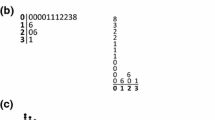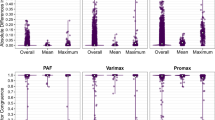Abstract
Studies in factorial ecology have typically used the principal factor procedure coupled with varimax rotation. Since it can be shown that the results one obtains vary according to the factor and rotation models he employs, and since there is no one “best” way of obtaining initial and derived factor solutions, it is proposed that future research in the area adopt an approach involving the simultaneous use of several different computing algorithms for obtaining initial solutions and both orthogonal and oblique rotation procedures to avoid the possibility that the results one obtains are not method-dependent. Ideally, the factor models employed should differ maximally with respect to the principles upon which they are based. If one finds a given factor regardless of the method he uses, only then can he assert with any confidencethat it is not an artifact of his method. Factorial ecologists are often interested in computing “factor scores”, but “true” factor scores are not uniquely computable; they can only be estimated. Since the proposed research strategy involves using either a component or an image model, in which the corresponding scores are exact and uniquely computable, the factor score problem is, in a sense, solved. Next it is suggested that, by using orthogonal solutions, factorial ecologists may be overlooking a very important piece of information—the correlation between the factors. There is some reason to believe that this varies from city to city, and may account for the fact that some factors which emerge in studies of Western cities are sometimes not found in cities elsewhere. Some comments are also made on the value of using census tract data, and on the availability of computer programs for different initial and derived factor solutions.
Similar content being viewed by others
References
Abdel-Latif, A. M. Forthcoming. Factor structure and change analysis of Alexandria, Egypt, 1947 and 1960. In Kent P. Schwirian (ed.), Comparative Urban Structure: Studies in the Ecology of Cities.
Abu-Lughod, Janet L. 1969. Testing the theory of social area analysis: the econolgy of Cairo, Egypt. American Sociological Review 34: 198–212.
Anderson, T. W., and H. Rubin, 1969. Statistical inference in factor analysis, Proceedings of the Third Berkeley Symposium on Mathematical Statistics and Probability 5:111–150.
Bartlett, M. S. 1937. The statistical conception of mental factors. British Journal of Psychology 28:97–104.
Bell, Wendell. 1955. Economic, family and ethnic status: an empirical test. American Sociological Review 20: 45–52.
Berry, Brian J. L., and Philip H. Rees. 1969. The factorial ecology of Calcutta. American Journal of Sociology 74:445–491.
Berry, Brian J. L., and Robert J. Tennant. 1965. Planning Guidelines: Commercial Structure. Chicago: Northeastem Illinois Planning Commission.
Gittus, Elizabeth. 1964-65. An experiment in the definition of urban sub-areas. Transactions of the Bartlett Society 2:109–135.
—. 1964. The structure of urban areas. Town Planning Review 35:5–20.
Guttman, Louis. 1953. Image theory for the structure of quantitative variates. Psychometrika 18:277–296.
Harman, Harry H. 1966a. Program for the Minres Method of Factor Analysis. System Development Corporation. Technical Memorandum TM-2958.
Harman, Harry H. 1966b. Program for the Maximum-Likelihood Method of Factor Analysis. System Development Corporation. Technical Memorandum TM-2960.
— 1967. Modem Factor Analysis. Chicago: University of Chicago Press.
Harris, Chester W. 1962. Some Rao-Guttman relationships. Psychometrika 27:247–263.
Harman, Harry H. 1967. On factors and factor scores. Psychometrika 32:363–379.
Harris, Chester W., and Henry F. Kaiser, 1964. Oblique factor solutions by orthogonal transformations. Psychometrika 29:347–362.
Harris, Margaret L., and Chester W. Harris. 1970. A Factor Analytic Interpretation Strategy. Wisconsin Research and Development Center for Cognitive Learning. Mimeographed.
Hawley, Amos H., and Otis D. Duncan. 1957. Social area analysis: a critical appraisal. Land Economics 33:337–345.
Holzinger, K. J., and H. H. Harman. 1941. Factor Analysis—A Synthesis of Factorial Methods. Chicago: University of Chicago Press.
Hotelling, Harold. 1933. Analysis of a complex of statistical variables into principal components. Journal of Educational Psychology 24:417–441 and 498–520.
Jones, F. Lancaster. 1965. A social profile of Canberra, 1961. The Australian and New Zealand Journal of Sociology 1:107–120.
Jöreskog, K. G. 1967. Some contributions to maximum likelihood factor analysis. Psychometrika 23:187–200.
Kaiser, Henry F. 1958. The varimax criterion for analytic rotation in factor analysis. Psychometrika 23:187–200.
Kaiser, Henry F., and J. Caffrey. 1965. Alpha factor analysis. Psychometrika 30:1–14.
Murdie, Robert A. 1969. Factorial Ecology of Metropolitan Toronto 1951–61. University of Chicago. Department of Geography Research Paper No. 116. Chicago: University of Chicago Press.
Nicholson, T. G., and Maurice H. Yeates. 1969. The ecological and spatial structure of the socio-economic characteristics of Winnipeg, 1961. Canadian Review of Sociology and Anthropology 6: 162–177.
Rao, C. R. 1955. Estimation and tests of significance in factor analysis. Psychometrika 20:93–111.
Schmid, Calvin F., and Kiyoshi Tagashira. 1964. Ecological and demographic indices: a methodological analysis. Demography 1:194–211.
Sweetser, Frank L. 1965. Factorial ecology: Helsinki, 1960. Demography 2:372–385.
Thomson, G. 1936. Some points of mathematical technique in the factorial analysis of ability. Journal of Educational Psychology 27:37–54.
Thurstone, L. L. 1935. Vectors of the Mind. Chicago: University of Chicago Press.
Author information
Authors and Affiliations
Rights and permissions
About this article
Cite this article
Hunter, A.A. Factorial ecology: A critique and some suggestions. Demography 9, 107–117 (1972). https://doi.org/10.2307/2060548
Issue Date:
DOI: https://doi.org/10.2307/2060548




